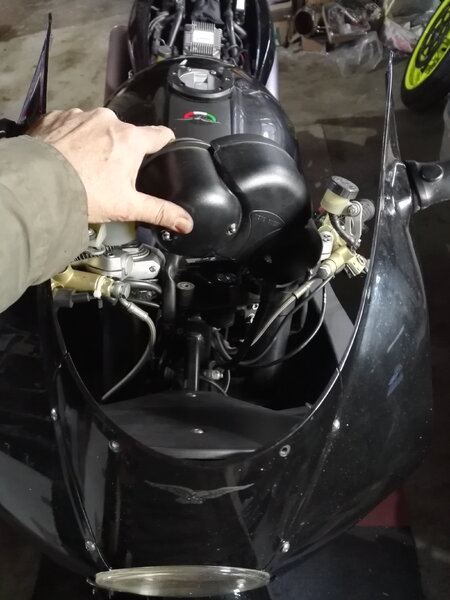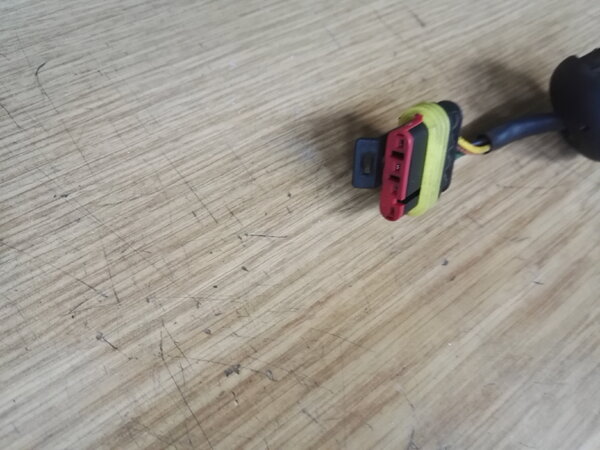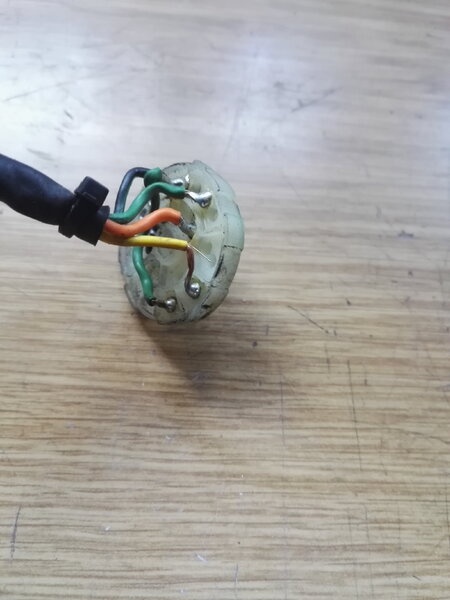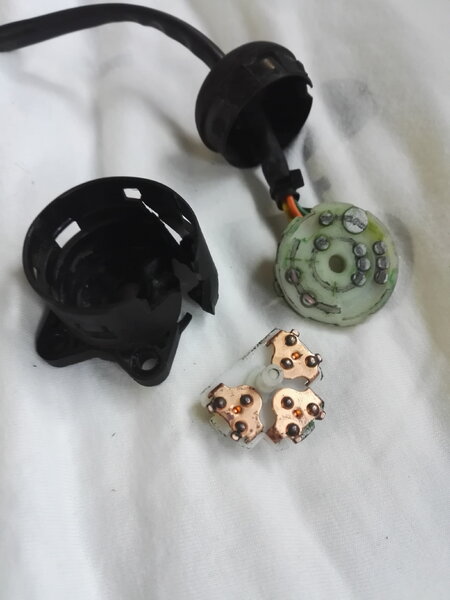
audiomick
Members-
Posts
2,507 -
Joined
-
Last visited
-
Days Won
50
Content Type
Profiles
Forums
Events
Gallery
Community Map
Everything posted by audiomick
-
It seems to be pretty easy to find here. A quick internet search brought about 10 hits. If it gets too hard, I could get you a couple of feet and send it over.
-
Don't forget to grease, check your rear drive shaft splines.
audiomick replied to Tomchri's topic in Older models
Indeed. A bloke might almost get a wee bit jealous looking at photos like that. That tin on the bench with the handlebar clamps on it, I've got one of those. It was a birthday present last year. I use it to store the good chocolate. -
That seems very sensible to me. I don't know how much a replacement costs, but it is certainly a lot less than repairing the carnage that can result from that joint breaking. Not to mention life and limb...
-
Yes, good to have. There is one in the garage I am in, but my garage "roommate" Ben generally has one of his bikes on it. I barely get a chance to use it. Ok, Ben did buy the lift, but still....
-
And keep an eye on the uni-joints. If there is even a hint of play in them, they need changing.
-
Thanks for the offer, Scud. Someone in the German forum has already indicated that he might have a switch lying around. If I can't find anything here, I'll get back to you. Here are some pictures of the damage: The back of the switch was broken off. I think the internals are all still there and intact. If I were to re-use the contact plate, I would re-solder the yellow wire. There is too much copper showing there for my taste, probably from being pulled out by force. It seems to me, the only thing that is really broken is the cup that it all sits in. Getting it all out was a bit of a fiddle. I had to dismantle to this extent Fairing screen off, and unbolt the instruments. I could get on to the screws to get the back of the switch off with a stubby #2 Phillips screwdriver. A bloody useless tool generally, but every workshop should have one for just such occasions. The plug is under the tank. I was able to raise the tank without unplugging anything just enough to get a piece of 2x1 under the front of it to hold it up whilst I unplugged the cable. Positive point: there doesn't seem to be any "tank swelling" going on. The bolt at the back of the tank came out and went back in very easily.
-
Yes, it was definitely tampered with. As I wrote, I just don't know whether the damage was already done when I took the battery out on the assumtion that it was flat, or whether the damage was done after that. The bike stood on the on-street parking bay all night. There were other signs that someone had messed around with it. The left mirror was pointing off at an odd angle, the lights were on high-beam (definitely not switched by me...). Someone had a good fiddle with it. I'm going around to the garage now to have a closer look at the damage...
-
Turns out the battery may not have been flat. I can't say for sure. I went in today, got the battery out and re-installed it. As I was about to try and start it, I noticed the contact plate of the ignition switch hanging out of the left side of the fairing. I don't know if the bike was tampered with before I tried to start it last night, or during the night after I took the battery out and put it on the charger in the store room. Anyway, I found the bit with the spring loaded copper contacts on it lying inside the fairing. With the help of a copious amount of electricians tape, I was able to make a contact, start the bike, and ride it to my garage. It is in there now, and I hope to be able to get it fixed fairly soon. First thing is to have a good look at the damage, then do some research into what parts and if they are available. As far as I could tell by squinting in under the instruments, the plastic cylinder that the whole business lives in is broken. I was too dispirited to have a closer look after I got it into the garage. Needless to say, I am not amused. Edit: the first results of an internet search are not very encouraging.... https://motorize.de/de/368980-moto-guzzi-v11-sport-2003-schlosssatz-tankdeckel-schlsser-zndschloss.html
-
Ran the battery flat. I rode it "the long way around" to work today. "Work" is in the Leipzig Opera House. As I was taking off my helmet, the Opera Director came past on his way to work. He greeted me, and commented on the bike and so on. As a result, I wasn't concentrating when I turned the key to engage the parking lock. I reckon I turned it all the way to "parking lights". When I tried to start it to go home after work, nothing. Fortunately: There are some tools under the seat. This occurred to me in time to stop me from just going home in a huff, and I took the battery out. I was all set to take the battery home on the tram, carrying the helmet and far too warmly dressed. Then it occurred to me that we (the sound and video department of the Opera House), by lucky coincidence related to a production that is running at the moment, have a CTEK battery charger set up ready to go in our storeroom. And I could leave the helmet and the excess clothing in my locker at work. So I went back in, plugged the battery onto the charger, and left the excess baggage in my locker. Hopefully, when I go back in tomorrow around midday after the forecast rain has stopped, I'll be able to put the battery back in and ride the bike home. And hopefully, the battery is not defunct. Also, I noticed when taking the battery out that the - terminal wasn't done up particularly tightly. The bonus would be that that is the cause of the starting problems it has been having. We'll see. More likely, I'll have to get a new battery, I reckon.
-
Another forlorn Guzzi owner looking for a V11 Le Mans Tenni
audiomick replied to Guzzi 1947's topic in Wanted
I could only find this one: https://www.ebay-kleinanzeigen.de/s-anzeige/guzzi-v11-le-mans-tenni/2394898251-305-7973 Looks ok, but a bit pricey, I reckon. -
The difference between "clearance" and "no clearance" is less than 1 mm. But the tip is good. I'll see if I can measure the clearance somehow. I'm thinking of it because one of the bolts holding the relay sockets to the frame doesn't have any clearance.
-
That indicates that one should avoid over tightening those screws, doesn't it?
-
Watches, clocks, and . . . sundials!
audiomick replied to p6x's topic in Special place for banter and conversation
With brass screws, of course. -
The only thing that gives me cause to stop and think is the height at 26mm. I gather the originals were 21mm. The ones in mine at the moment are 22mm. . Has anyone got the Picker items in a V11, and can comment on the clearance to the seat or lack thereof?
-
Quite rightly. Regardless of how much current is going through the contact, if it starts bouncing there wil be "constant" arcing across the contact. That is, over time, the end for the relay.
-
Yes, I know. I can see people's eyes glazing over as they read from here. Nevertheless, a quick word about coil resistance and power. I spoke once again to my electronic technician colleague. He confirmed that a solid state circuit providing the voltage to activate the coil of a relay would indeed be set up for a specific resistance, but the tolerance is likely to be very high. As long as the replacement has a resistance "in the same order of magnitude" it should be fine. He also confirmed the importance of a strong contact, particularly in a high vibration environment like in a motorcycle. Therefore docc's preference for a "stronger" coil is justified.
-
Regarding that: the spec. sheets refer to 10 ~ 40 Hz. . I thought that was probably to low to be relevant, but it turns out I was wrong. 2.4000 rpm is equivalent to 40 Hz, i.e. 2400(rpm )/ 60(seconds per minutes)=40 (Herz=cycles per second). So the stated frequency range is relevant to the lower part of the real world rev. range of the motor. Apart from that, other pennies have been dropping in the course of today. Regarding the coil resistance, which I hadn't done all that much till now: coil resistance is tied up with coil power, which docc has mentioned a couple of times. The corelation is in the formulae. Coil power can be calculated with the formula P = VI https://en.wikipedia.org/wiki/Electric_power and the current in the coil with I=V/R https://en.wikipedia.org/wiki/Electric_current The Picker spec. sheet quotes coil resistance at 120 Ohm for the 1.2 W version, as does the spec. sheet for the CIT relay. That gives us a current in the coil of 12V divided by 120 Ohm = 0.1 Ampere. So, negligible. Therefore I would assume that the coil power (apart from holding the relay open/closed under mechanically difficult conditions like excessive vibration) or coil resistance (looking at it from the other side) is pretty much irrevlevant. Mechanical switches such as the ignition switch, light switch, and so on, can certainly handle that sort of current. The exception might be the relay that is switched by the ECU. The switching voltage is generated by the ECU, a solid state circuit (i.e. probably a transistor). Such things are set up to expect a specific resistance at the othe end of the wire. If the resistance at the other end is too high, not enough current can flow (I=V/R, and V is constant). If the resistance is not high enough, too much current could flow, and the output stage of the ECU might shit itself. Therefore, I would not like to see the coil resistance /coil power for the specific relay that is switched by the ECU deviate to much from the specs of the original relay. Otherwise, I think that (coil resistance) is a spec. that doesn't have to interest us too much.
-
Splitting hairs: the manufacturer would most likely say that the spec. sheets support the claimed rating. We can only trust the spec. sheets, or not. Nevertheless, they both seem to be at the top of the range that I have seen for "high current" relays. "Bigger" ones, i.e. 40 A. or more, seem to jump to a 9.3 mm blade on the load connections (30 and 87/ 87a), so they wouldn't fit in the sockets. I like the Picker a little better, because the NC contact claims a higher rating (25A. vs 20A, both @ 14V). The "vibration resistance" spec has a higher number next to it (2.7mm double amplitude), but I don't know if that is relevant to our application.
-
That is probably the pertinent point. A "middle class" relay may well be "good enough" when the rest of the circuit is well maintained. When everything else is marginal, the problem is going to show up some where.
-
No. It's nit-picking, but it's also only about the definition of "nominal". In the accepted jargon, bikes and cars (nearly always) have a "12V electrical system". Look here: https://www.collinsdictionary.com/dictionary/english/nominal one talks about a "12V system" even though everyone knows the real voltage is not 12V. Therefore, per Definition, 12V is the nominal voltage. Nevertheless Yes. According to my limited knowledge of electrics, absolutely correct. and... Yes. An electrical part getting hotter than normal is an almost certain sign that a resistance is increasing or increased. By that I don't mean the component "resistor", but rather the resistance, for instance, across the contacts. i.e. if the relay starts getting hotter than it normally should be, it is a fair assumption that the contacts might be going bad = replace it. Edit: I suppose a bad contact in or to the socket could also make the relay heat up. That would be worth a look at before spending money on a new relay. another Edit: if a particular relay is always running a bit warmer than the others, then of course one could consider a higher rated relay in that position. One with a higher rating would most likely run cooler. The question is, is the relay in question running too hot? The temperatures you reported in that linked post, docc, don't look "too hot" to me. Highest reported temp. 147° F = just short of 64°C. That is still 20°C below the "max. temp." specs of typically 85°C that appear on various spec. sheets. So probably ok.








